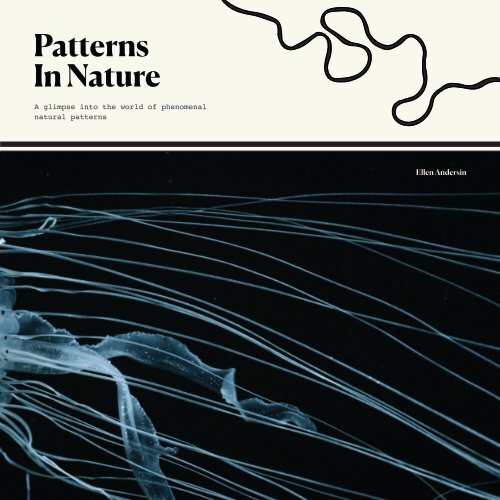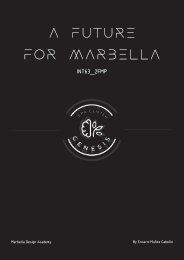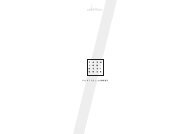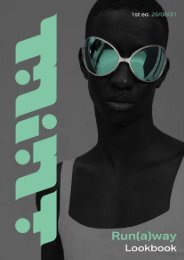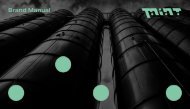Patterns in Nature, editorial design project by our 2nd-year student Ellen Andersin.
“Patterns In Nature”. A glimpse into the world of phenomenal natural patterns Editorial design project by our 2nd-year student Ellen Andersin. Marbella Design Academy - Spain – Founded 1995 - Tuition in English
“Patterns In Nature”.
A glimpse into the world of phenomenal natural patterns
Editorial design project by our 2nd-year student Ellen Andersin.
Marbella Design Academy - Spain – Founded 1995 - Tuition in English
You also want an ePaper? Increase the reach of your titles
YUMPU automatically turns print PDFs into web optimized ePapers that Google loves.
<strong>Patterns</strong><br />
In <strong>Nature</strong><br />
A glimpse <strong>in</strong>to the world of phenomenal<br />
natural patterns<br />
<strong>Ellen</strong> Anders<strong>in</strong>
<strong>Patterns</strong> <strong>in</strong> <strong>Nature</strong><br />
When observ<strong>in</strong>g the <strong>in</strong>credibly<br />
diverse natural world, one may f<strong>in</strong>d it<br />
overwhelm<strong>in</strong>g and complex. However,<br />
the reoccurr<strong>in</strong>g similarities become<br />
more evident, the more we look. First<br />
we notice the pattern of daily th<strong>in</strong>gs,<br />
the cycle of night and day, ocean<br />
waves hitt<strong>in</strong>g the coastl<strong>in</strong>e <strong>in</strong> perfect<br />
rhythm, and the moon and tides. But<br />
how is it possible the zebra’s stripes<br />
imitate the ripples of sand dunes?<br />
What we notice is that the same<br />
types of patterns, are often occurr<strong>in</strong>g<br />
at different places, hav<strong>in</strong>g noth<strong>in</strong>g to<br />
do with each other. Many patterns <strong>in</strong><br />
nature follow the same self organiz<strong>in</strong>g,<br />
spontaneous processes, which<br />
lead to a world full of similarities.<br />
From sea shell spirals to galaxies,<br />
the mirrored symmetry of most<br />
animals, to the branch<strong>in</strong>g networks<br />
of blood vessels, rivers and lightn<strong>in</strong>g.<br />
Explore these remarkable patterns of<br />
beauty, <strong>in</strong>novative <strong>design</strong> and most<br />
importantly; function.<br />
Symmetry 01.<br />
Fractals 02.<br />
Spirals 03.<br />
Chaos & Flow<br />
Waves & Dunes<br />
Bubbles & Foam<br />
04.<br />
05.<br />
06.<br />
Voronoi<br />
07.<br />
Cracks<br />
08.<br />
Spots & Stripes 09.
01.<br />
Symmetry<br />
Symmetry is one of the<br />
ma<strong>in</strong> concepts modern<br />
physicists use to<br />
understand the world,<br />
as well as what the<br />
ancient philosophers<br />
wished for <strong>in</strong> an<br />
ordered universe.<br />
Plato imag<strong>in</strong>ed a world<br />
created with geometric<br />
pr<strong>in</strong>ciples, based on<br />
harmony, proportion<br />
and symmetry.<br />
Symmetry allows us<br />
to reflect, rotate or<br />
move someth<strong>in</strong>g while<br />
rema<strong>in</strong><strong>in</strong>g look<strong>in</strong>g<br />
the same.<br />
1<br />
2<br />
<strong>Patterns</strong> <strong>in</strong> <strong>Nature</strong><br />
4
The majority of animals have mirrored<br />
external symmetry; humans, mammals,<br />
fish etc. Mirrored, or also called bilateral<br />
symmetry is recognized when you can<br />
draw a hypothetical vertical l<strong>in</strong>e <strong>in</strong> the<br />
middle of the animal and both sides are<br />
alike. Bilateral symmetry makes it easier to<br />
move <strong>in</strong> a specific direction, which expla<strong>in</strong>s this<br />
popularity <strong>by</strong> animals (1, 3). Bilateral symmetry<br />
also exist <strong>in</strong> plants, such as their leaves but also <strong>in</strong><br />
flowers like orchids. Plants, flowers and liv<strong>in</strong>g th<strong>in</strong>gs<br />
can arrange themselves <strong>in</strong> stunn<strong>in</strong>g symmetries.<br />
Some have threefold symmetry which means objects<br />
repeat themselves three times <strong>in</strong> a 120° axis, or<br />
have three “arms” or leaves. F<strong>our</strong>fold symmetry also<br />
happen among plants, fruits and other liv<strong>in</strong>g th<strong>in</strong>gs.<br />
Fivefold symmetry is found <strong>in</strong> for <strong>in</strong>stance sea creatures,<br />
like the family of ech<strong>in</strong>oderms which <strong>in</strong>clude star fish<br />
(4), sea urch<strong>in</strong>s and sea lilies. These however have<br />
evolved from bilateral symmetry, <strong>in</strong> fact their larvae<br />
are still bilateral. Fivefold symmetry is also<br />
3<br />
found <strong>in</strong> many flowers as well as some fruits.<br />
Snowflakes are an <strong>in</strong>credible example of<br />
sixfold symmetry. They repeat themselves<br />
<strong>in</strong> six arm <strong>in</strong> unique but similar shapes.<br />
Mov<strong>in</strong>g on to rotational symmetry. Th<strong>in</strong>k<br />
of jellyfish (2), it has a clear top and bottom<br />
but is rotationally symmetrical. If you look at it<br />
from the top and rotate it, it looks the same. This<br />
is common <strong>in</strong> plants (5) and some animals. Rotational<br />
symmetry is found at different scales among non-liv<strong>in</strong>g<br />
th<strong>in</strong>gs, for <strong>in</strong>stance the crown-shaped splash pattern<br />
formed when a drop falls <strong>in</strong>to water. Another example<br />
could be the shape and r<strong>in</strong>gs of a planet like Saturn. Sea<br />
anemones are radially symmetrical, which means their<br />
form is perfect s<strong>in</strong>ce their adults do not have to move, <strong>in</strong><br />
comparison to the animals with bilateral symmetry who<br />
move <strong>in</strong> a specific direction. The most common flowers<br />
feature this form as well, with a clear top, bottom, middle<br />
po<strong>in</strong>t and the petals grow<strong>in</strong>g <strong>in</strong> a 360° shape around.<br />
4 5<br />
5 Symmetry
02.<br />
Fractals<br />
Natural fractals may<br />
look very chaotic when<br />
you first see them;<br />
mounta<strong>in</strong> profiles,<br />
trees and coastl<strong>in</strong>es<br />
do not have any exact<br />
symmetry. However,<br />
fractals have a so<br />
called “hidden logic”<br />
to their patterns;<br />
hierarchical repetition<br />
and self-similarity at<br />
decreas<strong>in</strong>g scales.<br />
1 2<br />
<strong>Patterns</strong> <strong>in</strong> <strong>Nature</strong><br />
6
Look<strong>in</strong>g at a picture of coastl<strong>in</strong>es, clouds and river<br />
networks without a scale bar makes it hard to know<br />
if it conta<strong>in</strong>s meters, kilometers or hundreds of<br />
kilometers of <strong>in</strong>formation. When zoom<strong>in</strong>g <strong>in</strong>, the<br />
same shapes occur, <strong>in</strong> a self repeat<strong>in</strong>g manner; If you<br />
are shown just a bit of it, you can’t tell how much of<br />
the whole it represents. Therefore, a fractal is a self<br />
repeat<strong>in</strong>g pattern <strong>in</strong> different levels, that looks similar<br />
at any scale. The structure starts from simple shapes<br />
that multiply over time but keep the same pattern,<br />
which means it looks more complex at larger scales.<br />
In mathematics, fractals are <strong>in</strong>f<strong>in</strong>ite, but <strong>in</strong> nature<br />
this is not perfectly possible, so all fractal patterns <strong>in</strong><br />
nature are only approximate. For <strong>in</strong>stance, real objects<br />
are made of an actual substance and can’t get smaller<br />
than the atoms they are made of. Equally there is an<br />
upper limit, you do not get trees as big as mounta<strong>in</strong>s.<br />
Examples of Fractals occurr<strong>in</strong>g <strong>in</strong> nature are tree<br />
branches (1,3), lightn<strong>in</strong>g, galaxies, clouds, blood<br />
vessels, as well as ocean waves, coastl<strong>in</strong>es, river<br />
3<br />
networks and mounta<strong>in</strong>s (2). Fractals <strong>in</strong> nature are<br />
not <strong>in</strong>f<strong>in</strong>ite as mentioned, so they only have a certa<strong>in</strong><br />
amount of levels to them. For example a Romanesco<br />
broccoli (5) might only have 3-4 levels of self-similarity.<br />
Fractal branches <strong>in</strong> biology have a useful role. The<br />
passages of y<strong>our</strong> lungs, the networks of arteries, ve<strong>in</strong>s<br />
and capillaries <strong>in</strong> the vascular system are all fractal<br />
systems. Same for the networks <strong>in</strong> trees and their ve<strong>in</strong><br />
systems of leaves (4). These branch<strong>in</strong>g networks are<br />
the most efficient <strong>in</strong> terms of energy, whether it’s to<br />
transport air, blood or the sugary sap of a plant. Their<br />
structure makes the amount of energy needed to<br />
transport the fluids to all po<strong>in</strong>ts, as small as it can be.<br />
4 5<br />
7 Fractals
03.<br />
Spirals<br />
Spirals are everywhere<br />
<strong>in</strong> the universe, <strong>in</strong><br />
both large and small<br />
scales; snail shells,<br />
galaxies, cyclonic<br />
storms and plants.<br />
Most spirals <strong>in</strong> nature<br />
have a shape called<br />
logarithmic, which<br />
means that a small<br />
part looks just like<br />
the bigger part, like<br />
fractals. A snail shell<br />
that grows <strong>in</strong> this<br />
form can stay the same<br />
shape even as it gets<br />
even bigger. What makes<br />
spirals popular <strong>in</strong><br />
nature then?<br />
1 2<br />
<strong>Patterns</strong> <strong>in</strong> <strong>Nature</strong><br />
8
The most important factor to<br />
name is that these spirals are<br />
different than the spiral you get<br />
when you’re roll<strong>in</strong>g up the garden<br />
hose. In that case, the width of the<br />
coils are the same <strong>in</strong> every turn. This<br />
spiral is called an Archimedean spiral and 3<br />
like Archemedes described it; usually comes from<br />
roll<strong>in</strong>g up a long or flat object with a constant width.<br />
The natural snail shell (5) spiral becomes larger for<br />
every turn <strong>in</strong> a specific, logarithmic way, s<strong>in</strong>ce its<br />
mathematical equation <strong>in</strong>volves logarithms. What<br />
makes this spiral remarkable then? The shape rema<strong>in</strong>s<br />
the same no matter how small or big it is. As the<br />
spiral rotates <strong>in</strong>to its center, it only gets narrower<br />
and narrower and the curvature gets tighter and<br />
tighter. The spiral knows no limits; it can go on curl<strong>in</strong>g<br />
<strong>in</strong>ward or outward forever and rema<strong>in</strong> unchanged.<br />
The difference with the Archemedean spiral can<br />
be expla<strong>in</strong>ed with the impossibility of coil<strong>in</strong>g the<br />
garden hose tighter than its width.<br />
It’s not just molluscs that feature<br />
the logarithmic spiral (1), so do plants<br />
like ferns (4), animal horns and claws,<br />
though these might not even complete a<br />
full turn. Spiral galaxies (2) such as the Milky<br />
Way often have logarithmic shapes, as well as<br />
cyclones and hurricanes. The head of a sunflower (3) is<br />
made up of two spirals rotat<strong>in</strong>g <strong>in</strong> opposite directions.<br />
The Fibonacci Sequence is very common <strong>in</strong> radially<br />
symmetrical plants. If you count the pattern of seeds<br />
<strong>in</strong> a sunflower, for <strong>in</strong>stance, the number is equal to the<br />
Fibonacci Sequence. The leaflets of p<strong>in</strong>e cones have the<br />
same structure as the sunflower, and the Romanesco<br />
broccoli’s florets as well. Their arrangement of leaf<br />
motion, or phyllotaxis, is based on the same structure,<br />
the Fibonacci sequence. The structure allows the<br />
plant to constantly grow but stay secure and strong.<br />
The spiral shape maximizes their sun and ra<strong>in</strong>water<br />
<strong>in</strong>take, while tak<strong>in</strong>g up the least amount of space.<br />
4 5<br />
9 Spirals
04.<br />
Flow<br />
& Chaos<br />
The universe is always<br />
on the move. From<br />
clouds of gas and dust;<br />
stars form. Water<br />
circulates around<br />
the oceans <strong>in</strong> loops,<br />
driven <strong>by</strong> salt<strong>in</strong>ess and<br />
temperature differences.<br />
Rivers flow down from<br />
mounta<strong>in</strong>s <strong>in</strong> branch<strong>in</strong>g<br />
formations like the<br />
blood flows <strong>in</strong> <strong>our</strong><br />
ve<strong>in</strong>s. Many of these<br />
flows are too turbulent<br />
and fast to be<br />
predictable or ma<strong>in</strong>ta<strong>in</strong><br />
a constant form. Yet<br />
there is still order.<br />
1<br />
<strong>Patterns</strong> <strong>in</strong> <strong>Nature</strong><br />
10
2 3<br />
The fundamental forms of fluid flow, such as the<br />
whirpool vortex (2), can be recognized from cyclones,<br />
water go<strong>in</strong>g down the dra<strong>in</strong>, as well as when you stir<br />
y<strong>our</strong> coffee <strong>in</strong> a cup. The pattern is harder to see when<br />
for <strong>in</strong>stance fast flow<strong>in</strong>g water runs chaoticly <strong>in</strong> a river.<br />
To see the order <strong>in</strong> the flow more clearly, we need to<br />
slow it down. For <strong>in</strong>stance, when water is calmly flow<strong>in</strong>g<br />
down a smooth stream, the water runs <strong>in</strong> straight paths.<br />
If we then add an obstacle <strong>in</strong> the flow, let’s say a rock<br />
stick<strong>in</strong>g up, it disturbs the smooth lam<strong>in</strong>ar flow. How<br />
it is disturbed depends on several th<strong>in</strong>gs; the viscosity<br />
of the liquid (water and syrup respond differently), the<br />
size of the obstacle and the speed of the flow. If the flow<br />
is slow enough, it gently passes around the object and<br />
then comes together on the other side. Then, when<br />
the flow is a bit faster, a pair of sp<strong>in</strong>n<strong>in</strong>g eddies appear<br />
beh<strong>in</strong>d the object. Even faster flow creates a wavy<br />
undulation, mean<strong>in</strong>g a wavelike motion and when they<br />
grow, they “break” and curl over <strong>in</strong>to a tra<strong>in</strong> of vortices.<br />
This phenomena is known as a Kármán vortex street<br />
(3), and creates zigzagg<strong>in</strong>g, mesmeriz<strong>in</strong>g patterns.<br />
Fluid flow can not only become a patterned<br />
phenomenon, but creates patterns as well <strong>by</strong><br />
leav<strong>in</strong>g permanent traces beh<strong>in</strong>d. Streams, rivers<br />
and oceans pick up sand, stones and sediment and<br />
rearrang<strong>in</strong>g the landscape with erosion after them.<br />
Meanders of rivers (1,4) are fully developed <strong>by</strong> water<br />
transport<strong>in</strong>g sediment, with <strong>in</strong>put of fluid flow and<br />
its speed. S<strong>in</strong>ce the water flows faster on the<br />
outside of the edge of the curv<strong>in</strong>g river meander, it<br />
erodes more, while aga<strong>in</strong> it flows slower on the<br />
<strong>in</strong>side where sediment gets collected. This<br />
forms the rivers to bend and curl more<br />
and more over time, and eventually<br />
two sides of the loop meet and<br />
merge. The stronger this<br />
phenomenon gets the<br />
4<br />
more complex the<br />
meanders get.<br />
11<br />
Chaos & Flow
05.<br />
Waves<br />
& Dunes<br />
In a way, most of<br />
nature is basically<br />
waves; light and sound<br />
are undulations,<br />
mean<strong>in</strong>g they move <strong>in</strong><br />
wave-like patterns.<br />
Oceans and the<br />
atmosphere support<br />
oscillations, the<br />
repetitive movement <strong>in</strong><br />
time and, <strong>in</strong> general,<br />
waves are patterns <strong>in</strong><br />
time, as well as space.<br />
It is a constant pulse,<br />
a periodic com<strong>in</strong>g<br />
and go<strong>in</strong>g.<br />
1<br />
<strong>Patterns</strong> <strong>in</strong> <strong>Nature</strong><br />
12
2 3<br />
Waves are spread throughout nature and carry<br />
energy as they move. Sound waves are vibrations<br />
of the air (4), while light is a wave of oscillat<strong>in</strong>g<br />
electrical and magnetic fields, mov<strong>in</strong>g through<br />
space faster than anyth<strong>in</strong>g else. Collid<strong>in</strong>g waves<br />
may re<strong>in</strong>force or cancel out one another, depend<strong>in</strong>g<br />
on whether they are <strong>in</strong> or out of step. Interference<br />
of light waves may result <strong>in</strong> spectacular colors,<br />
like soap or oil films on water. When sound waves<br />
are restricted to a fixed space, like an <strong>in</strong>strument,<br />
certa<strong>in</strong> frequencies and patterns may be picked<br />
out <strong>in</strong> the phenomenon of resonance. The 18th<br />
century scientist and musician Ernst Chladni<br />
discovered that it is possible to create <strong>in</strong>terest<strong>in</strong>g<br />
patterns of scattered f<strong>in</strong>e gra<strong>in</strong>s (2), lay<strong>in</strong>g on<br />
a metal plate, only from sound wave vibrations<br />
when draw<strong>in</strong>g a viol<strong>in</strong> bow across the edge.<br />
Sea surface waves create a chaotic pattern on<br />
water, driven <strong>by</strong> w<strong>in</strong>d waves. As waves <strong>in</strong> water or<br />
w<strong>in</strong>d pass over sand, patterns of ripples appear (1),<br />
and if bigger, dunes are created. Different patterns<br />
form <strong>in</strong> dunes when the w<strong>in</strong>d arranges sand gra<strong>in</strong>s <strong>in</strong>to<br />
regular structures; crescents, long l<strong>in</strong>es, stars, domes<br />
or parabolas, and they may look very different from<br />
another. These self organiz<strong>in</strong>g patterns are based on<br />
the particular speed of the w<strong>in</strong>d and the average gra<strong>in</strong><br />
size. This is why dunes on other planets, let’s take Mars<br />
as an example (3), may also have similar dunes but form<br />
patterns not possible on Earth. The different conditions<br />
affect the ways the gra<strong>in</strong>s are transported and how they<br />
bounce; the gravity is weaker or Mars, the atmosphere<br />
is th<strong>in</strong>ner and the w<strong>in</strong>ds can be much faster.<br />
4<br />
13 Waves & Dunes
06.<br />
Bubbles<br />
& Foam<br />
Someth<strong>in</strong>g as playful<br />
as soap bubbles have<br />
fasc<strong>in</strong>ated scientists<br />
for a long time.<br />
Bubbles and foam have<br />
a certa<strong>in</strong> charm and<br />
beauty to them but also<br />
extraord<strong>in</strong>ary shapes.<br />
Soap bubbles hold the<br />
smallest possible<br />
surface area for the<br />
volume enclosed, <strong>in</strong><br />
their sphere shapes.<br />
A mass of bubbles, or<br />
foam, are simply guided<br />
<strong>by</strong> the laws of physics<br />
<strong>in</strong>to astonish<strong>in</strong>g<br />
hexagonal patterns.<br />
1<br />
2<br />
<strong>Patterns</strong> <strong>in</strong> <strong>Nature</strong><br />
14
3 4<br />
The masters of hexagons, apart from physics of<br />
c<strong>our</strong>se, are the bees with their honeycomb (1,2). They<br />
demonstrate precious eng<strong>in</strong>eer<strong>in</strong>g <strong>in</strong> their array<br />
of prism-shaped cells with a perfectly hexagonal<br />
cross-section. Yet this structure is made without<br />
any bluepr<strong>in</strong>t; <strong>by</strong> simultaneously work<strong>in</strong>g bees,<br />
somehow manag<strong>in</strong>g to be coord<strong>in</strong>ated. The wax<br />
walls are made with precise thickness and they even<br />
manage to avoid mismatched cells somehow.<br />
The other question is; why hexagons? Because of<br />
geometry. If you want to pack cells together that are<br />
all identical <strong>in</strong> shape and size, so that they fill a flat<br />
surface, only three regular shapes work. They all have<br />
identical sides and angles and it is either equilateral<br />
triangles, squares or hexagons. Out of these three, the<br />
hexagons require the least amount of wall compared<br />
to the others of the same area. The bees make their<br />
walls from wax which require energy to produce, so<br />
the hexagons are the most economic choice (5).<br />
Foams (4) are even more concerned about economy<br />
than bees. The soap bubbles are made of water with<br />
a sk<strong>in</strong> of soap molecules and the surface tension is<br />
constantly pull<strong>in</strong>g towards a structure that holds the least<br />
amount of soap-film wall, mean<strong>in</strong>g the smallest liquid<br />
surface area as possible. At the same time the structure<br />
has to be mechanically stable and this is part of the<br />
reason why you for <strong>in</strong>stance never see square bubbles; if<br />
f<strong>our</strong> bubbles would be surrounded and pressed <strong>by</strong> f<strong>our</strong><br />
walls, they <strong>in</strong>stantly rearrange <strong>in</strong>to three-wall junctions.<br />
This is rooted <strong>in</strong> the dom<strong>in</strong>ant preferences of science.<br />
The eyes of <strong>in</strong>sects (3), with their many light-sensitive<br />
cells are packed hexagonally, like the foams, with only<br />
three cell walls meet<strong>in</strong>g at each vertex.<br />
5<br />
15<br />
Bubbles & Foam
07.<br />
Voronoi<br />
What do giraffes, corn<br />
on the cob and leaf<br />
cells have <strong>in</strong> common?<br />
They all feature the<br />
natural pattern called<br />
Voronoi Tessellation.<br />
The pattern is based<br />
on efficiency, cutt<strong>in</strong>g<br />
l<strong>in</strong>es to the nearest<br />
neighbor with the<br />
shortest path available<br />
<strong>in</strong> the tightest<br />
fit possible.<br />
1 2<br />
<strong>Patterns</strong> <strong>in</strong> <strong>Nature</strong><br />
16
3 4<br />
The Voronoi pattern (1) is very common <strong>in</strong> the natural<br />
world, most fashionably worn <strong>by</strong> giraffes (4) and<br />
turtles (3). The dragonfly (5) shows off this irregular<br />
pattern <strong>in</strong> their w<strong>in</strong>gs, and a regular Voronoi pattern<br />
looks like the bees’ honeycomb. Most commonly<br />
the Voronoi cells are irregular, for <strong>in</strong>stance <strong>in</strong><br />
the case of the turtle. Y<strong>our</strong> food may feature this<br />
pattern as well; corn on the cob as mentioned,<br />
p<strong>in</strong>eapples, strawberries and a head of garlic.<br />
The Voronoi Tessellation is one sort of Tessellations<br />
<strong>in</strong> nature. This category features patterns build <strong>by</strong><br />
repeat<strong>in</strong>g tiles over a flat surface. Th<strong>in</strong>k of reptiles,<br />
like snakes (2), or fish with their astonish<strong>in</strong>g scales,<br />
they all have these protect<strong>in</strong>g, overlapp<strong>in</strong>g scales<br />
and tiles. Some other animals have this pattern as<br />
well, like the pangol<strong>in</strong> or alligators, fruits like the<br />
salak and flowers as the snake’s head fritillary.<br />
The Voronoi pattern is build up based on its middle seed<br />
po<strong>in</strong>ts. Picture a number of randomly placed dots. Each<br />
seed or dot has its own region, or cell, consist<strong>in</strong>g of all the<br />
po<strong>in</strong>ts of area that is closer to that seed than any other.<br />
Imag<strong>in</strong>e that each seed would blow up like a bubble, all<br />
<strong>in</strong> the same speed. The cell walls or l<strong>in</strong>es of the Voronoi<br />
is where the bubbles would meet<br />
each other.<br />
5<br />
17<br />
Voronoi
08.<br />
Cracks<br />
Cracks and breakage<br />
seem to be the absolute<br />
opposite of order and<br />
organization, but<br />
these patterns appear<br />
very often <strong>in</strong> nature.<br />
Therefore, the only<br />
possibility is that<br />
they also produce<br />
patterns and structure.<br />
“Geometry of failure”<br />
comes from th<strong>in</strong>gs<br />
break<strong>in</strong>g and crack<strong>in</strong>g;<br />
creat<strong>in</strong>g branch<strong>in</strong>g,<br />
jagged, forked and<br />
fragmented patterns.<br />
1 2<br />
<strong>Patterns</strong> <strong>in</strong> <strong>Nature</strong><br />
18
The branch<strong>in</strong>g tips of cracks, split <strong>in</strong>to ever more<br />
junctions, which means this category shows yet<br />
another fractal system <strong>in</strong> nature. These patterns not<br />
only appear <strong>in</strong> the crack<strong>in</strong>g of mud (4), but can also<br />
be recognized <strong>in</strong> rivers’ networks. These branch<strong>in</strong>g<br />
networks have a k<strong>in</strong>d of “slow crack” as they erode<br />
the landscape <strong>in</strong> which they form, splitt<strong>in</strong>g apart<br />
the earth and carv<strong>in</strong>g mounta<strong>in</strong> ranges. The sea,<br />
as well, is constantly erod<strong>in</strong>g the coastl<strong>in</strong>es, with<br />
the energy of the water’s movement, creat<strong>in</strong>g<br />
random fractal patterns. These geological processes<br />
happen over decades, centuries and millennia.<br />
Lightn<strong>in</strong>g (3) has a very similar pattern to the<br />
branch<strong>in</strong>g, fractal networks. When the high voltage<br />
electricity travels through and splitt<strong>in</strong>g a material,<br />
a dielectric breakdown happens. What’s <strong>in</strong>terest<strong>in</strong>g<br />
is that the pattern of the lightn<strong>in</strong>g crack is like a<br />
frozen replica of the spark that started it, called the<br />
Lichtenberg figure. The electricity flow generally<br />
chooses the path wherever the electric field at the<br />
boundary of the discharge is the strongest, which<br />
usually is at the sharpest po<strong>in</strong>ts, at bulges and tips. This<br />
is why lightn<strong>in</strong>g bolts often strike at the highest trees or<br />
build<strong>in</strong>gs and why lightn<strong>in</strong>g conductors are sharp spikes;<br />
they enc<strong>our</strong>age the electrical discharge to happen there.<br />
Shr<strong>in</strong>kage stress is a huge reason for cracks to appear,<br />
for <strong>in</strong>stance when mud dries up and shr<strong>in</strong>ks, cracks<br />
appear where the stress is the strongest. The same<br />
happened <strong>in</strong> the case of the Giant’s Causeway (2), where<br />
<strong>in</strong>stead of mud it’s magma that cooled down, shrank<br />
and cracked. The islands of these patterns usually have<br />
a polygonal shape, even though <strong>in</strong> most cases they can<br />
be less smooth and <strong>in</strong>consistent (1). However, <strong>in</strong> the<br />
case of the Giant’s Causeway, with its highly regular,<br />
almost geometric shapes, it is hard to believe this is<br />
from the same process. When cracks grow downward<br />
<strong>in</strong> a thick layer of mass, the cracks tend to break up<br />
<strong>in</strong>to prism shaped columns with the pattern gett<strong>in</strong>g<br />
more organized, the deeper the cracks get. Additionally,<br />
about 60 millions of <strong>year</strong>s of erosion has removed the<br />
uneven, top layers of the Giant’s Causeway, expos<strong>in</strong>g<br />
only the strik<strong>in</strong>g, honeycomb-like, natural pattern.<br />
3 4<br />
19 Cracks
09.<br />
Spots<br />
& Stripes<br />
Animals have the most<br />
<strong>in</strong>credible <strong>design</strong>s of<br />
patterns, and one may<br />
wonder how and why they<br />
are this way. It is one<br />
th<strong>in</strong>g to discuss why;<br />
it may be a process<br />
of natural selection<br />
and camouflage, but<br />
what scientists have<br />
struggled to expla<strong>in</strong><br />
is how these mark<strong>in</strong>gs<br />
appear. In the end,<br />
it has more to<br />
do with mathematics<br />
than biology.<br />
1 2<br />
<strong>Patterns</strong> <strong>in</strong> <strong>Nature</strong><br />
20
3 4<br />
All k<strong>in</strong>ds of <strong>in</strong>novative patterns are worn <strong>by</strong> animals,<br />
but they do seem to follow certa<strong>in</strong> trends. The stripe<br />
pattern of the zebra (1) surely is a popular one,<br />
with some fish, tigers, antelopes, caterpillars and<br />
frogs wear<strong>in</strong>g the same mark<strong>in</strong>gs. Spots are also<br />
seen widely <strong>in</strong> the animal world, like on leopards,<br />
ladybirds, fish and <strong>in</strong>sects. The reasons for these<br />
patterns may be as warn<strong>in</strong>g signs for predators,<br />
or as a tool to recognize members of the same<br />
species. Camouflage is a popular feature, to fade<br />
as well <strong>in</strong>to the surround<strong>in</strong>gs as possible, or the<br />
opposite; to attract and impress the opposite sex for<br />
mat<strong>in</strong>g, like the peacock’s strik<strong>in</strong>g tail feathers (3).<br />
Now the question is, how does the embryo of a zebra<br />
get impr<strong>in</strong>ted with these stripes? How does the<br />
pigment produc<strong>in</strong>g sk<strong>in</strong> cells organize and <strong>design</strong><br />
which part that should be dark or light? The widely<br />
accepted explanation <strong>by</strong> scientists is that these<br />
patterns are an outcome of a self-organiz<strong>in</strong>g process<br />
also seen <strong>in</strong> many different natural pattern mak<strong>in</strong>g<br />
phenomena. It was the mathematician Alan Turn<strong>in</strong>g<br />
who came up with the formula. He watched the<br />
process of embryos and found that it was chemicals<br />
that moved across the embryo that formed these<br />
patterns. The pr<strong>in</strong>ciple is that the process requires both<br />
activator and <strong>in</strong>hibitor chemicals and <strong>in</strong> the simplest<br />
case, zebra stripes are born. With these two <strong>in</strong>gredients<br />
you can make almost endless amounts of patterns,<br />
sometimes need<strong>in</strong>g an extra <strong>in</strong>gredient <strong>in</strong> the mix. So<br />
while the pelt pigmentation of tigers, leopards, zebras,<br />
giraffes and more come <strong>in</strong> many different patterns,<br />
they all come from the same biochemical process.<br />
The mesmeriz<strong>in</strong>g patterns of bird feathers are usually<br />
cont<strong>in</strong>uous, and the colors are actually<br />
established before the feathers get<br />
divided up <strong>in</strong>to separate barbs.<br />
Reptiles and amphibians are also<br />
known for their mark<strong>in</strong>gs, colorful<br />
patterns and even po<strong>in</strong>tillist patterns like the<br />
chameleon (2). The reptiles with scales actually<br />
have similar, very geometric patterns underneath<br />
the top layer too. Butterflies seem to have no limits,<br />
sport<strong>in</strong>g stripes, dots and elements like eye spots<br />
and outl<strong>in</strong><strong>in</strong>gs of ve<strong>in</strong>s. Fish and sea creatures (5)<br />
also have <strong>in</strong>credible mark<strong>in</strong>gs of spots and stripes,<br />
but <strong>in</strong> even more stunn<strong>in</strong>g, bright colors (4).<br />
5<br />
21 Spots & Stripes
Credits<br />
While the text is written<br />
<strong>by</strong> <strong>Ellen</strong> Anders<strong>in</strong>, a huge<br />
s<strong>our</strong>ce of <strong>in</strong>spiration and<br />
access to <strong>in</strong>formation was<br />
the book <strong>Patterns</strong> In <strong>Nature</strong>,<br />
<strong>by</strong> Philip Ball (Chicago and<br />
London: The University of<br />
Chicago Press, 2016). Another<br />
great s<strong>our</strong>ce of <strong>in</strong>formation<br />
was the ECstep’s website<br />
on “Natural <strong>Patterns</strong>”.<br />
To make this <strong>project</strong> possible<br />
and visually strik<strong>in</strong>g;<br />
s<strong>in</strong>cere gratitude to the<br />
many photographers and<br />
users on Unsplash, Flickr,<br />
Pexels and Pixabay.<br />
Graphic Design <strong>by</strong><br />
<strong>Ellen</strong> Anders<strong>in</strong><br />
2021<br />
<strong>Patterns</strong> <strong>in</strong> <strong>Nature</strong><br />
22
This book explores the diverse and <strong>in</strong>novative<br />
<strong>design</strong>s of nature, with the different types of<br />
natural pattern<strong>in</strong>g processes happen<strong>in</strong>g around us.<br />
With breathtak<strong>in</strong>g pictures, we take a look at how<br />
the zebra pa<strong>in</strong>ts its coat, why the trees branch<br />
like rivers, and how the spirals of sea shells<br />
are similar to galaxies and plants.<br />
<strong>Patterns</strong> <strong>in</strong> <strong>Nature</strong><br />
24


